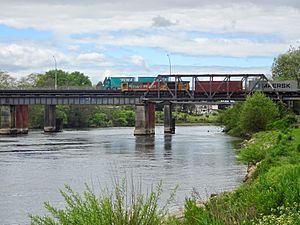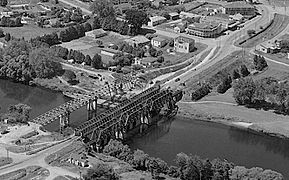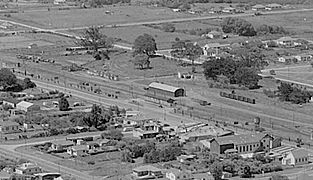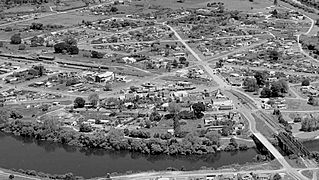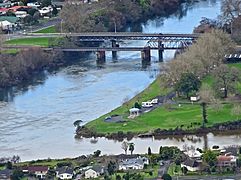Ngāruawāhia railway station facts for kids
Quick facts for kids
Ngāruawāhia railway station
|
|
|---|---|
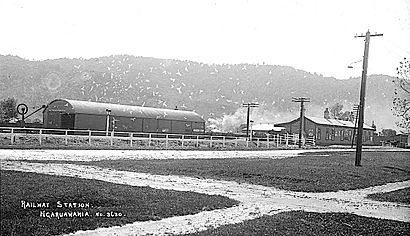
Ngāruawāhia station, about 1910.
Alexander Turnbull Library, Wellington |
|
| Location | Ngāruawāhia New Zealand |
| Coordinates | 37°40′05.9″S 175°08′56.1″E / 37.668306°S 175.148917°E |
| Owned by | KiwiRail Network |
| Line(s) | North Island Main Trunk |
| Tracks | double track from 4 December 1938 |
| History | |
| Opened | 13 August 1877 |
| Closed | 29 July 1978 (goods), 1975 (passengers) |
| Previous names | Newcastle until 1878 |
Ngāruawāhia railway station was an important train stop in New Zealand. It was located where the main North Island Main Trunk railway line met the Glen Massey branch line, in the town of Ngāruawāhia. This town is about 74 kilometers south of Auckland and 10 kilometers north of Hamilton. The station first opened on Monday 13 August 1877. It stopped serving passengers in 1975 and goods in 1978. The stations closest to Ngāruawāhia were Taupiri, 6.5 kilometers to the north, and Horotiu, 5.5 kilometers to the south.
In 2020, there was a plan to reopen the remaining platform as part of a COVID-19 recovery project. This project was estimated to cost about $15 million.
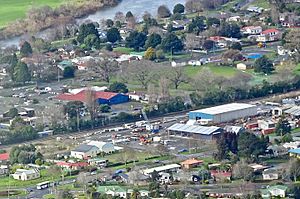
Contents
Station History
The station first opened on 13 August 1877. At that time, it was called Newcastle. It was the end of the railway line that stretched 31 kilometers from Mercer. The stationmaster's house was built a bit later. The station was no longer the end of the line when the railway was extended to Te Awamutu on 1 July 1880. The station's name was changed to Ngāruawāhia in 1878.
Just two months after it opened, a platform was built across from the Delta Hotel in the town center. However, the goods shed, where items were stored, stayed to the south.
Station Buildings Over Time
In 1902, a book called The Cyclopedia of New Zealand described the station. It had a wooden building with an asphalt platform. There was also a goods shed, rooms for lamps and luggage, a ladies' room, and a public waiting room. The stationmaster had an office, and there was even a post office inside the station.
A new station building was reported to be open in 1915. However, in 1916, the station was "rearranged considerably." This seems to be when it was moved to a spot about halfway between the hotel and the goods shed. Electric lights were added to the station in 1921, making it much brighter.
How Many People Used the Station?
More and more people used the station over the years. The biggest increase happened at the start of World War 2. This was probably because many soldiers and their families were traveling to and from the Hopuhopu army camp nearby.
Waikato River Bridges
The railway line at Ngāruawāhia crosses the Waikato River. Over the years, two main bridges have been used for trains.
The First Bridge (1877)
Work began on a road-rail bridge over the Waikato River in late 1874. This bridge was special because both trains and cars could use it. It had three long sections, each about 36 meters long. The bridge was almost finished by April 1876, and a test train ran over it. It opened for road traffic in December 1876. Finally, it opened for trains on 13 August 1877, the same day the station opened.
Gates, controlled by a person in the bridgekeeper's house, would stop road traffic when a train was coming. Even though there were plans to remove the house in 1929, it stayed until the bridge was taken down in 1968.
The Second Rail Bridge (1931)
By 1928, the first bridge needed repairs, so it was decided to build a new one. The new bridge was built about 10 meters downstream (further along the river) from the old one. This bridge was only for trains. It had six sections and was a total of 137 meters long. It was designed by the NZR and used over 253 tons of steel. The steel parts were made in Britain and put together by A & G Price. The bridge cost £25,000.
The last rivet was put in place in February 1931. The first train crossed the new bridge on 13 March 1931. By November 1931, the old bridge was being used only for road traffic going north.
1974 Train Accident
On 14 July 1974, 21 wagons of a train going south went off the tracks. They piled up on the northernmost part of the 1931 bridge. This happened after an axle on one of the wagons broke.
2002 Bridge Repair
On 14 March 1998, part of a train hit the 1931 bridge. This meant that two of the bridge's main support structures needed to be replaced. This repair work was done in 2001 and 2002 by McConnell Smith.
Gallery


